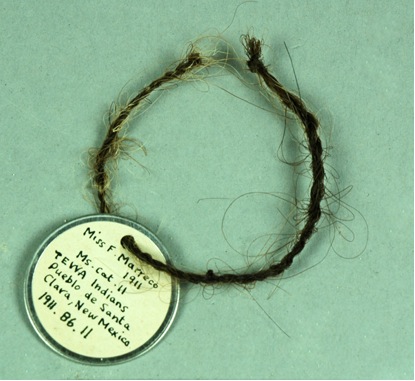Hair ring for a baby
Tewa people, New Mexico, USA, early 20th century
 Collected and donated by Barbara Freire-Marreco in 1911; 1911.86.11The collector and donor of this ornament, Barbara Freire-Marreco, was one of the first students to graduate in the new subject of anthropology from Oxford, gaining a diploma distinction in 1908. In 1910, after taking an interest in the wittings of the Pueblo Indians she travelled to the USA. During her fieldwork in the American Southwest she made a point of collecting "ordinary everyday objects" made and used by the people with whom she lived.
Collected and donated by Barbara Freire-Marreco in 1911; 1911.86.11The collector and donor of this ornament, Barbara Freire-Marreco, was one of the first students to graduate in the new subject of anthropology from Oxford, gaining a diploma distinction in 1908. In 1910, after taking an interest in the wittings of the Pueblo Indians she travelled to the USA. During her fieldwork in the American Southwest she made a point of collecting "ordinary everyday objects" made and used by the people with whom she lived.
A Tewa man from New Mexico named Santiago Naranjo gave this ornament to Freire-Marreco. It is made of his own hair, twisted into a small ring. Santiago said that it was worn by his sickly baby on the ankle when he was working away from home because it kept the baby "from taking too much thought of her father". Yet the baby son of Santiago's grown-up daughter, Eulogia, wore a similar kind of ornament, even though the father was at home and the child in good health. When asked why this was so, the explanation came, "because when a child is weak, we make a ring of someone's hair that is strong".
